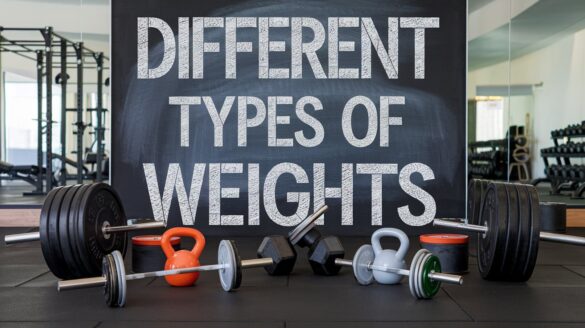Intro
Having an understanding of the kinds of weights available and how to go about using them in workouts is very instrumental in optimizing returns from any exercise. It is in light of this that this blog seeks to outline different kinds of weights, their uses, benefits, and ways through which a trainer can incorporate these weights into their training regime.
Different Kinds of Weights
Dumbbells
Fixed Dumbbells
These are non-adjustable weights and come in varying weights and sizes.
Benefits:
The durability and ease of use make dumbbells a god option for any home gym as well as a commercial gym
-versatile for a huge number of exercises starting from curls, presses, ending with rows.
Adjustable Dumbbells
These weights allow adjusting the level of resistance.
Benefits:
Space and money are saved by opening the home gym.
Uses: Great for lots of different exercises that incorporate different levels of resistance.
Barbells
Standard Barbells
Typically 5-6 ft. in length, with their weight capacity typically pre-determined.
Pros: Versatile and Easy to use for beginners
Uses: Bench presses, Deadlifts, Squats
Olympic Barbells:
7 ft. in length. Designed for Olympic weightlifting therefore have rotating sleeves.
Pros: More weight can be placed on them. Excellent for professional weight lifting
Uses: Olympic lifts. Heavy squats. Deadlifts
Specialty Barbells
Hex bars. Trap bars. Safety Squat bars.
Benefits: Less injury potential with isolated musculature.
Uses: Deadlifts, squats, bench presses.
Kettlebells:
Weight made of cast iron or steel with a handle attached to the weight.
Benefits: Functional strength, endurance, coordination.
Uses: Swings, snatches, Turkish get-ups.
Weight Plates
Standard Plates
Lighter and smaller typically with a 1″ hole. Benefits: Light, easy to handle, fits standard barbells. Uses: Applications include progressive overload for most exercises.
Olympic Plates
Bigger and heavier typically rubber coated and a 2″ hole.
Advantages: Heavy and more permanent, used in competitive weightlifting.
Applications: Good for heavy squats and deadlifts.
Bumper Plates
A full rubber weight plate designed to be dropped.
Benefits: Floor and equipment protection; noise dampening.
Applications: Olympic lifting, CrossFit.
Medicine Balls
Weighted balls available in a variety of weights and diameters
Benefits: Power, coordination, core strength
Uses: Throws, slams, partner work
Sandbells and Sandbags
Soft, flexible weights, filled with sand
Benefits: Versatile; grip strength and stability
Exercises: Functional training; carries, slams, lunges
Weight Machines
Machines with set weights and pulleys
Benefits: Guided movements, less chance of injury
Exercises: Beginning exercises, rehabilitation, isolated muscle training.
Training with different kinds of weights has some benefits.
First of all, there are free weights. They have two main benefits: greater range of motion and balance and coordination.
In addition, more muscle fibers are activated, increasing overall strength and development. Then, there are weight machines.
Such kinds of weights are safer because they provide more control when weight training. The application of this is the best way to isolate some definite muscle, thus reducing the possibility of probable injury.
Finally, there are specialty weights. These weights have such benefits as exercise that increases functional strength and coordination, serving for enhancing the athletes’ general performance.
Training Focus: Simulates life movements and provides stability.
How to Choose the Right Weights for Your Goals
For Strength and Power
Recommended Weight:
Barbells and dumbbells
Exercise Examples:
Squats, deadlifts, bench presses.
For Muscle Growth
Recommended Weights A mix of all:
dumbbells, barbells and weight machines.
Exercise Examples
Isolation exercises and compound movements
Functional Fitness
Recommended Weights
Kettlebells, Sandbags, Medicine balls
Exercise Examples
Swings, Carries, Dynamic movement
Beginners and Rehabilitation
Recommended Weights
Weight Machines and Lighter Free Weights
Exercise Examples
Exercises performed on machines that limit the pattern of movement.
FAQs
What are some advantages to training with free weights compared to machines?
Free weights activate more muscle fiber and balance and coordination. Therefore, they contribute to better overall strength development.
Can I train my whole body with kettlebells?
Yes, kettlebells are so versatile that one can work on full-body exercises with them to develop strength, endurance, and coordination.
Are weight machines good for building muscle?
Yes, weight machines can be good for keeping the muscle isolated, and thus this will help the beginners or even people coming off an injury.
What kind of weights would one use to do functional training?
Kettlebells, sandbags, medicine balls—all these are fabulous tools for functional training.
Weight Selection—How to Choose the Right Weight Start with a weight in which you can do the exercise correctly in the number of repetitions to which you are working up.
Gradually increase the weight over time as your strength and confidence increase.
Conclusion
Knowing what kinds of weights exist and what each has in store is only one of the biggest keys to making the best decisions in your regime in fitness.
After all, it’s possible that gaining strength, muscle, and functional fitness through the hitting of different weights is just what it takes to bump up performance and result in workouts.
Knowing the range of weights with their benefit ranges will let appropriate decisions be made in the field of fitness.
Be exposed to different weights in your workout, and you will further diversify your performance at the gym and get results concerning a strong, muscle-growing, functionally fit body.

